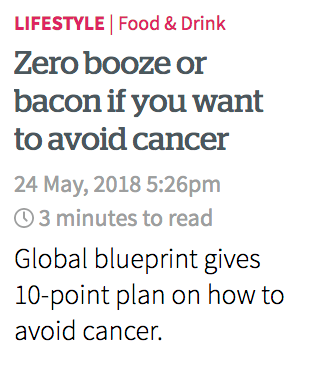Does bacon prevent cancer?
No.
This isn’t even supposed to be new research: it’s just a new set of guidelines based on all the same existing research. Since it’s a new set of public guidelines, you’d think a link would be appropriate: here it is.
The story says “”No level of intake” of processed meats will reduce cancer risks.” and the quote from the report is The data show that no level of intake can confidently be associated with a lack of risk. I don’t think that will surprise many people, and it’s what we’ve been told for a long time. There isn’t a magic threshold where bacon switches from being a health food to being bad for you. If you want something more quantitative, the figures we had last bacon panic haven’t changed: eating an extra serving of bacon every day is estimated to increase your lifetime bowel cancer risk by a factor of 1.2, or a bit under two extra cases per hundred people.
For alcohol, the focus on cancer is a bit misleading. Low levels of alcohol consumption increase cancer risk but reduce heart disease risk, and there’s a range where it’s pretty much a wash — there isn’t a ‘safe level’ from a cancer viewpoint, but there probably is from a not-dying viewpoint. Still, there are lots of people who’d be healthier if they drank less alcohol — and that’s probably not the first time they’ve heard the message.
Thomas Lumley (@tslumley) is Professor of Biostatistics at the University of Auckland. His research interests include semiparametric models, survey sampling, statistical computing, foundations of statistics, and whatever methodological problems his medical collaborators come up with. He also blogs at Biased and Inefficient See all posts by Thomas Lumley »

I still wish that the proposed warning labels for alcoholic beverages would just put up the risk curves from DiCastelnuovo & Donati 2006 (or any better more recent metastudy – the most recent one wasn’t bad if you use the version buried in the appendix that had non-drinking as baseline instead of light drinking).
7 years ago
Abstainers as a group contain people who choose to abstain and those that must abstain e.g. alcoholics and people on certain medications or with certain health conditions (epiletics).
So the risk curve for a healthy individual should be based on individuals like themselves e.g. healthy individuals with the same age, sex and SES.
A generic risk curve is going to give a false impression.
7 years ago
It’s not easy to analyse abstainers correctly. But if you’re not going to include abstainers you can’t really make claims about the absence of a J-curve (as they did).
7 years ago